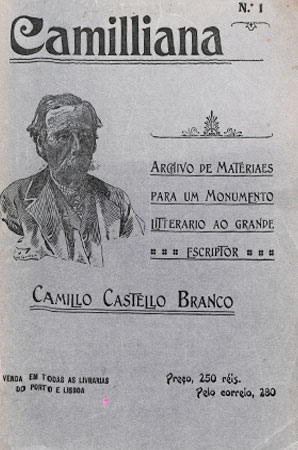
"Camilliana" intends to be a tribute to the late writer Camilo Castelo Branco. It was common practice in this period to create magazines with a view to honoring a public figure of great importance, as was the case with the northern writer. A portrait of Camilo, twenty years before his suicide, in 1870, is printed as an illustration between the pages of the introduction.
We are informed, in the cover, that this commemoration was a subsidiary of the newspaper O tripeiro, which appeared in O’Porto in 1908.
Thus, in this publication there are several types of texts included in his honor: from correspondence to poetry, even attention is due to an internationalist side of the literary figure of Camilo. Here, "Some notes" are notorious about an Italian translation of Amor de Perdição, an article signed by Luis Ferreira de Lima, as well as news of a celebration commemorating the author's memory, in Brazil, organized by the Grémio Republicano Português in Rio de Janeiro.
In the field of poetry, Henrique Marques talks about “Um soneto de Camilo” ('A sonnet by Camilo'), a lesser-known facet of the writer, and another sonnet by the author is transcribed in an early part of the magazine, entitled "O teu retrato" (‘Your portrait’).
The issue, moreover, opens with a chronicle of the last days of the author of A Queda de um Anjo (The Fall of an Angel). A chronicle somewhat romanticized and written with some intertexts revealed from the readings of the time (Heine, Wolff, etc), but it has the valuable intention of being written by Mello Freitas a few weeks after the writer's suicide. In a later chronicle, the last five years of his life are also mentioned, with an allusion to his aristocratic consecration by D. Luís I, in 1885, when he was granted the lifetime title of Visconde de Correia Botelho. The chronicle, written while he was still alive, clearly defends the figure of Camilo, saying that he should had been allowed to write two or three more books to see how the title would not influence his literary talent.
Despite the enthusiasm of this Camillian invective and the inclination to continue the magazine in more issues, the project seems to have failed because it had no follow-up - which was also common - and remained for a single issue.
Ricardo Marques
